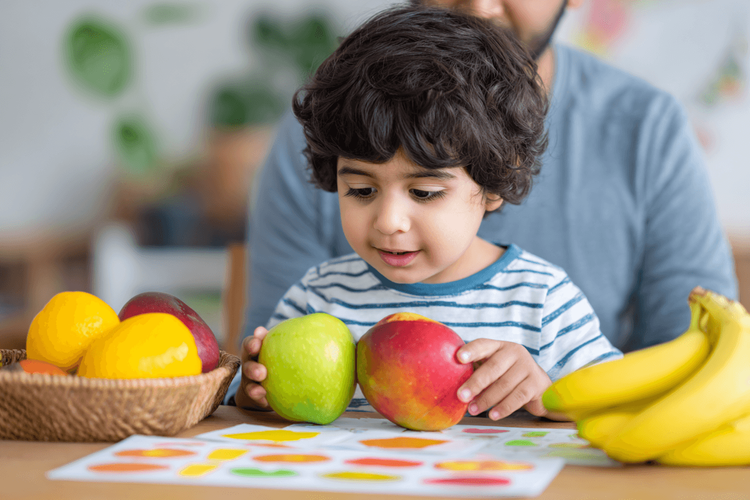10 Fruits Name for Kids to Build English Vocabulary

Table of Contents
Learning fruit names in English may seem like a small task, but it lays the foundation for vocabulary, sentence building, and spoken fluency. These words are easy to learn, fun to speak, and connect directly to a child’s daily life.
At PlanetSpark, we believe language should not be memorised through flashcards or repeated drills. Instead, it should be explored, spoken, and used with confidence. Something as simple as a fruit can become a powerful tool to help children start their English-speaking journey.
10 Fruits Name in English for Kids
| Category | Fruit Name | Color | Taste |
|---|---|---|---|
| Citrus Fruits | Orange | Orange | Sweet–sour |
| Lemon | Yellow | Sour | |
| Tropical Fruits | Mango | Yellow/Orange | Sweet |
| Banana | Yellow | Sweet | |
| Pineapple | Yellow | Sweet–tart | |
| Berries | Strawberry | Red | Sweet–sour |
| Cherry | Red | Sweet | |
| Green Fruits | Kiwi | Brown (outside), Green (inside) | Tangy–sweet |
| Grapes | Green or Purple | Sweet or sour | |
| Melons | Watermelon | Green (outside), Red (inside) | Sweet |
Start by helping your child pronounce these names. Repeat them aloud together, point to real fruits, and use visuals wherever possible. Recognition is the first step to vocabulary building.
Turning Fruit Names into Sentences
Once your child can say the names, the next step is forming simple sentences. This helps with grammar, sentence structure, and fluency.
Here are examples of how each fruit can be used in a sentence:
| Fruit | Sentence |
|---|---|
| Apple | An apple is red and crunchy. |
| Banana | A banana is long, yellow, and soft. |
| Mango | Mangoes are sweet and juicy. They are my favourite fruit. |
| Orange | Oranges are round and full of juice. |
| Pineapple | A pineapple has a rough skin but tastes very sweet inside. |
| Grapes | Grapes are small and grow in bunches. They can be green or purple. |
| Kiwi | Kiwis are brown on the outside and green on the inside. |
| Watermelon | Watermelons are big, red inside, and perfect for summer. |
| Strawberry | Strawberries are red, juicy, and have tiny seeds on their skin. |
| Cherry | Cherries are small, red, and taste both sweet and sour. |
You can start by saying these sentences together, then let your child describe fruits on their own using words like colour, taste, or shape.

Every confident speaker once needed a little nudge. This is theirs.
Book a demo class today and watch their confidence grow!
How Naming Fruits Helps Kids Speak English with Confidence
When a child learns to name fruits in English, they are doing more than memorising vocabulary. They are beginning to observe, think, and speak in English about the world around them. Fruits are familiar, visual, and often part of a child’s daily life, which makes them ideal for building early language confidence.
Naming fruits like "apple" or "banana" becomes a gateway to forming simple sentences. With practice, children move from saying one word to expressing full thoughts like “This is a mango. It is yellow and sweet.” These moments of expression lay the groundwork for fluent communication.
At home, these fruit words can spark small conversations. In the classroom, they serve as speaking prompts and storytelling cues. This natural use of everyday vocabulary helps children move from passive learners to active English speakers. This transition is key to long-term language mastery.
Ready to turn everyday words into fluent conversations?
Book a free demo class and see how PlanetSpark transforms simple vocabulary into confident spoken English for your child.
Make Learning 10 Fruits Name in English a Fun Daily Activity
Teaching your child the 10 fruits name in English doesn’t have to feel like a lesson. It can become a playful part of their daily routine. Fruits are colourful, tasty, and familiar, which makes them the perfect tool for natural English learning.
Here are simple ways to make fruit names fun and interactive:
Name Fruits Together During Meals: While eating fruits like bananas or apples, say their names in English. Encourage your child to repeat after you.
Play ‘Guess the Fruit’: Cover a fruit with a cloth and ask your child to guess its name in English by touching or smelling it.
Fruit Shopping Game: At the grocery store, ask your child to find and name different fruits using English words.
Draw and Label Fruits: Let your child draw fruits and write their names in English beside each picture.
Taste and Talk: When tasting fruits, encourage sentences like “The orange is sweet” or “The pineapple is sour.”
Story time with Fruits: Make up short stories using fruit names as characters. For example, “Once there was a mango who loved the rain.”
To support this journey, explore our full spoken English course, designed to help kids move from word recall to fluent, confident speaking.

Use Descriptive Words to Grow Vocabulary
Once children know the 10 fruits name in English, they can enhance their vocabulary by adding simple descriptive words. This makes their sentences richer and improves expressive ability.
Here are some useful describing words for fruits:
→ Juicy: full of juice
→ Crunchy: makes a sound when chewed
→ Sweet: sugary taste
→ Sour: sharp or tangy taste
→ Soft: easy to bite
→ Seed: small part inside a fruit
→ Peel: outer layer of a fruit
Try This: Ask your child to describe a fruit using two adjectives.
Example: “The orange is juicy and sweet.”
Why Parents Trust PlanetSpark for Spoken English
PlanetSpark is India’s leading platform for communication skills and spoken English training for children. Here’s why thousands of parents prefer us:
1:1 Personalised Classes: Expert trainers focus on grammar, vocabulary, and fluency in one-to-one sessions.
AI Progress Tracking: SparkX video tool offers instant feedback on voice, delivery, and confidence.
Fun, Gamified Learning: Kids improve spelling, grammar, and vocabulary through interactive quizzes.
Showcase Opportunities: Storytelling contests and open mics help children gain stage confidence.
Regular Parent Updates: PTMs and detailed reports keep parents involved in every step of their child’s progress.
Thousands of parents choose PlanetSpark because they see real, measurable progress in their child’s communication skills and you can too.
Book your free demo class now and give your child the confidence to speak up, stand out, and shine
Conclusion
Learning the 10 fruits name in English is not just about identifying food. It is about using simple, everyday words to unlock a bigger world of spoken English. With the right approach, these first steps become the building blocks of clear, confident communication.
At PlanetSpark, we take your child from word lists to real-life speech using expert training, AI feedback, and creative activities.
FAQs
Q1: At what age should children start learning fruit names in English?
Children can start as early as age 3. Fruits are easy to recognise and often part of daily life, which makes them ideal for early vocabulary development and spoken English practice.
Q2: Why is learning fruit names useful for spoken English?
Fruit names provide familiar, visual cues that help children form simple sentences and express themselves with confidence. This builds a strong foundation for fluency.
Q3: My child knows the fruit names but struggles to speak in full sentences. What should I do?
Start by encouraging them to describe each fruit using colors, taste, or size. For example: “The mango is yellow and sweet.” You can also get expert guidance through PlanetSpark’s personalised spoken English training.
Q4: How can I make fruit name learning more interactive at home?
Use games like fruit basket talk, drawing and describing, or matching names with real fruits. These methods turn passive learning into active speaking practice.
Q5: How does PlanetSpark use everyday words like fruits in their spoken English course?
Our expert trainers use common words like fruits to help children build fluency through storytelling, sentence construction, and real-life speaking prompts.
Q6: Are there tools to track my child’s spoken English progress?
Yes. With our AI-powered SparkX video analysis, you receive regular performance insights covering voice, grammar, fluency, and confidence. Progress reports are shared with parents frequently.
Q7: Will learning fruit names help my child in school?
Absolutely. It enhances vocabulary, supports reading comprehension, and boosts speaking confidence during oral exams, class presentations, and storytelling tasks.
Personalized Communication Report
Record a video to get a AI generated personalized communication report for your child

Hi There, want to try these
tips for your child with
LIVE with our expert coach?
Let's check your child's
English fluency
